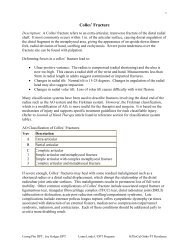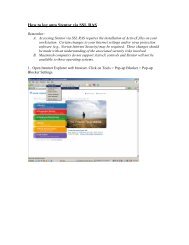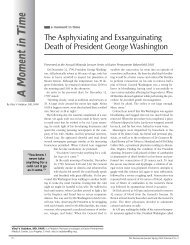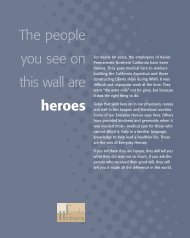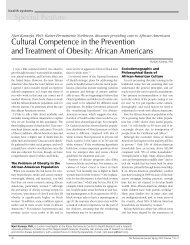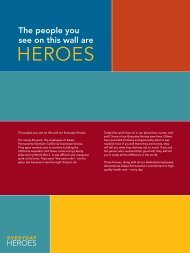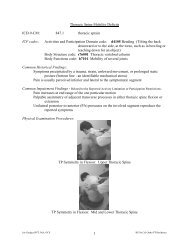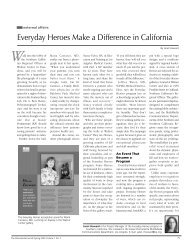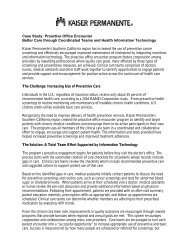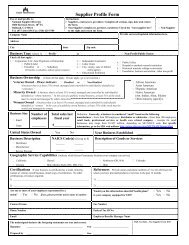Abdominal Cutaneous Nerve Entrapment Syndrome (ACNES): A ...
Abdominal Cutaneous Nerve Entrapment Syndrome (ACNES): A ...
Abdominal Cutaneous Nerve Entrapment Syndrome (ACNES): A ...
You also want an ePaper? Increase the reach of your titles
YUMPU automatically turns print PDFs into web optimized ePapers that Google loves.
<strong>Abdominal</strong> <strong>Cutaneous</strong> <strong>Nerve</strong> <strong>Entrapment</strong> <strong>Syndrome</strong> <strong>ACNES</strong>: A Commonly Overlooked Cause of <strong>Abdominal</strong> Pain<br />
first place the middle finger of one hand in the<br />
aponeurotic opening and then, without lifting<br />
the finger off the skin, move the fingertip inferiorly,<br />
cleanse the skin with alcohol using the<br />
other hand, and with that hand introduce the<br />
needle above the tip of the examining finger.<br />
When the needle is properly situated beneath<br />
the aponeurosis, the clinician stabilizes the syringe<br />
for injection by gripping it using the same<br />
hand used to locate the opening. The patient<br />
should be asked not to breathe during aspiration<br />
and injection. These instructions may seem<br />
rudimentary; however, if followed exactly, they<br />
will guarantee success in diagnosing and treating<br />
<strong>ACNES</strong>.<br />
A patient who feels faint after receiving the<br />
injection should be allowed to lie down until<br />
s/he feels better; otherwise, the patient should<br />
be encouraged to move about the room. When<br />
the syringe has been disposed of and the patient<br />
has taken a few steps, the clinician should<br />
ask if the patient still feels pain. If the injection<br />
has been effective, patients often volunteer,<br />
with a look of amazement on their faces, “It’s<br />
gone!” Clinical response sometimes takes more<br />
time than this if the injection has been made slightly<br />
off the locus. If the response is mediocre and the clinician<br />
suspects the reason may be because the injection<br />
was not placed accurately, a second injection may be<br />
attempted after about ten minutes or on another day.<br />
Occasionally, a patient reports relief from pain upon<br />
arriving home. In such circumstances, a patient should<br />
be encouraged to return to the clinic if the pain recurs<br />
or if new symptoms arise.<br />
Mehta 4 and McGrady 17 used a Teflon-coated needle<br />
with exposed tip to locate the nerve by electrical stimulation.<br />
I tried this technique with several patients and<br />
found the procedure cumbersome and time-consuming.<br />
After learning to locate the nerve as described<br />
here, clinicians can place the injection accurately in<br />
minutes without using a nerve locator.<br />
In many patients, one injection gives prolonged relief<br />
or may sufficiently reassure younger patients that<br />
the condition is benign and will not require another<br />
visit unless another injection is needed for pain relief.<br />
Older persons should be advised to return whenever<br />
the pain recurs or when other symptoms develop so<br />
that underlying causes can be addressed if necessary.<br />
Because repeat injection requires only a few minutes<br />
in patients who have already been evaluated, these<br />
patients may often be scheduled for a same-day ap-<br />
The Permanente Journal/ Summer 2002/ Volume 6 No. 3<br />
Figure 3. Clinician locating the precise injection site.<br />
clinical contributions<br />
(Adapted and reproduced by permission of the publisher, of the authors, and of the illustrator,<br />
Marjorie Domenowske, from: Bonica JJ, Johansen K, Loeser JD. <strong>Abdominal</strong> pain caused by<br />
other diseases. In: Bonica JJ, editor. The management of pain. 2nd ed Vol 2. Philadelphia: Lea<br />
& Febiger; 1990. p 1254-82. 24 )<br />
pointment, even to evaluate new associated symptoms.<br />
An alternative is to schedule three return appointments<br />
a few days apart, a tactic that gives patients the option<br />
to cancel the appointment if they do not think they<br />
need it. Some patients need multiple injections to eliminate<br />
the pain completely, but these patients seldom<br />
need more than four or five injections. Each injection<br />
should provide relief for a longer and longer time until<br />
no more are needed. For patients who tolerate<br />
local anesthesia well but must return every<br />
few weeks for another injection, alternative<br />
regimens are available.<br />
The clinician must first decide whether further<br />
evaluation is justified. Does the patient<br />
have musculoskeletal conditions (eg, scoliosis<br />
or one short leg) that might subject a particular<br />
nerve to undue traction? Especially in<br />
older patients, are underlying medical problems<br />
causing abdominal enlargement? If for<br />
any reason the pain is recurrent or persistent, it can be<br />
treated by destroying the symptomatic portion of the<br />
nerve. Some patients with <strong>ACNES</strong> have nerve entrapment<br />
in an abdominal scar. 6,16-18 Excising this part of<br />
the scar or removing the suture from around the nerve17 In many patients,<br />
one injection gives<br />
prolonged relief or<br />
may sufficiently<br />
reassure younger<br />
patients that the<br />
condition is<br />
benign …<br />
may solve the problem by two mechanisms: 1) relief<br />
of direct compression of the nerve and 2) relief of dis-<br />
25



